Breakdown Drills for Teaching the Pack Line Defense
By Dr. James Gels, From the Coach’s Clipboard Basketball Playbook"Helping coaches coach better..."
Disclosure: This page contains affiliate links, which means that Coach's Clipboard receives a small commission (at no cost to you) if you make a purchase using these links.
The pack line man-to-man defense is designed to clog the seams and stop the dribble-drive. It is a gap defense, that still puts pressure on the ball. These breakdown drills will you teach the pack line defense. But first see Pack Line Defense.
1-on-1 Drill
On-ball defenders must become proficient at "guarding your yard" and containing the dribbler 1-on-1. See the diagrams 1-3. X1 hands the ball to O1 and O1 tries to score. O1 is permitted just three dribbles (this is also a good drill for offensive players to work on their dribble attack). If X1 stops the offensive player (diagram 2), the offensive player goes to the back of the line, and X1 hands the ball to the next player in line, and now O2 attacks X1.X1 continues defending a long as he/she gets stops. The goal is three consecutive stops, and then everyone but the defender (the winner) does five push-ups. If the offense scores (diagram 3), then X1 goes to the back of the offense line, and the player that just scored becomes the new defender, looking for three stops.
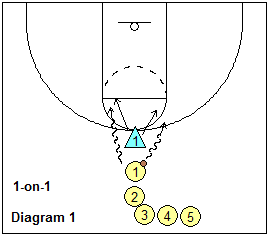
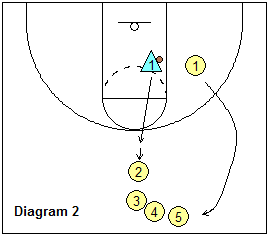
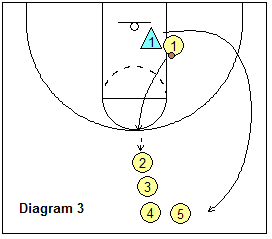
2-on-2 Positioning Drills
These 2-on-2 drills work on correct positioning in the gaps, and good close-outs on the ball. All of these 2-on-2 drills should be done on both the right and left sides of the court. Have the players pass back and forth several times, and then switch offense and defense.2-on-2 Top to Wing Drill
Diagram 4 shows X1 pressuring the ball (O1). X2 is in the gap below the imaginary packline, and a good step away from his/her man (toward the ball), with a somewhat closed stance (so as to not lose sight of his/her man). As O1 passes to O2, O2 closes out on O2 (with high hands) and pressures the ball, while O1 jumps to the ball and drops below the packline in the gap (diagram 5). O1 and O2 pass back and forth several times, and then the offense and defense switch.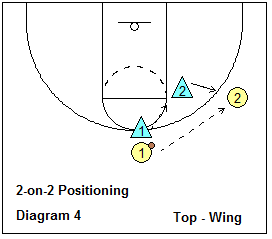
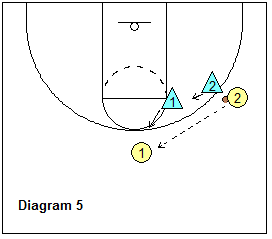
2-on-2 Top to Corner Drill
Diagram 6 shows X1 pressuring the ball (O1). X2 is in the gap below the imaginary packline. As O1 passes to O2, X2 closes out on O2 (with high hands) and pressures the ball while denying the baseline. X1 jumps to the ball and drops below the packline in the gap. Diagram 7 shows the pass back to the top with X1 closing out on O1 and X2 dropping into the gap below the packline. Again, after several passes, rotate offense and defense.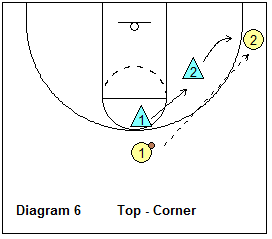
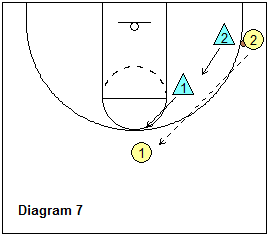
2-on-2 Wing to Corner Drill
Diagram 8 shows X1 pressuring the ball (O1), starting now on the wing. X2 is in the gap below the imaginary packline. As O1 passes to O2, X2 closes out on O2 (with high hands) and pressures the ball while denying the baseline. X1 jumps to the ball and drops below the packline in the gap. Diagram 9 shows the pass back to the wing with X1 closing out on O1 and X2 dropping into the gap below the packline. After several passes, rotate offense and defense.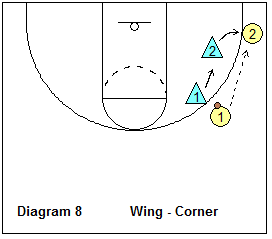
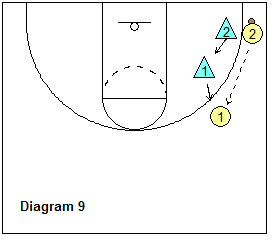
2-on-2 Two-Guard Front Drill
Diagram 10 shows the offensive players in a two-guard front. X1 is pressuring the ball (O1). X2 is in the gap below the imaginary packline. As O1 passes to O2, X2 closes out on O2 (with high hands) and pressures the ball. X1 jumps to the ball and drops below the packline in the gap. Diagram 11 shows the pass back to O1 with X1 closing out on O1 and X2 dropping into the gap below the packline. After several passes, rotate offense and defense.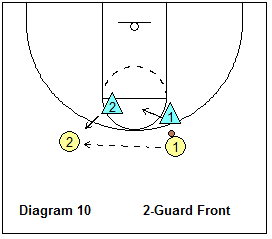
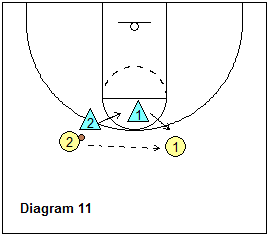
3-on-3 Drills
These 3-on-3 drills also work on correct positioning in the gaps, and good close-outs on the ball.3-on-3 Positioning Drill
This drill is similar to the 2-on-2 drills above except now we are using three guards as seen in diagram 12. The offensive perimeter players remain stationary, passing the ball around the arc, as the defenders rotate and position themselves correctly in the gaps. We want good close-outs and pressure on the ball.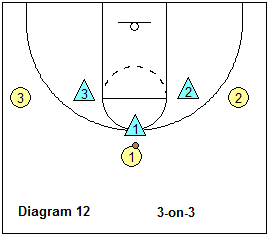
3-on-3 Drill, with Coach
Diagram 13 shows the coach with the ball, with three other perimeter offensive players and three defenders positioned correctly in the gaps. The coach might dribble from side to side, in which case the three defenders should always be inside the imaginary packline. If the coach passes to a player (diagram 14), then that defender (here X1) closes out and pressures the ball. That player must then pass back to the coach (diagram 15), and all defenders must position themselves correctly in the gaps, inside the packline. The coach might yell "Freeze!" at any time, to examine and critique the positioning. Offensive players are free to cut, screen, and move anywhere.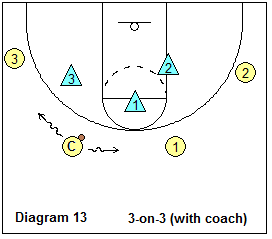
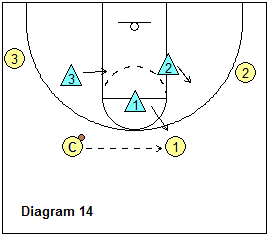
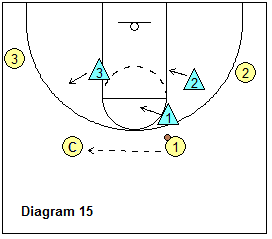
The following drills are from former Xavier Head Coach Chris Mack.
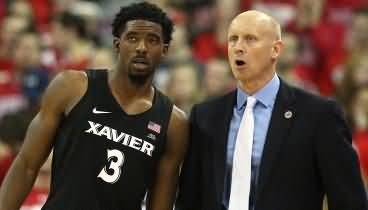
Former Xavier Head Coach Chris Mack
Perimeter Defense - GOLDEN RULE: always have two feet inside the packline when your man does not have the ball except for when (1) your man becomes a cutter, or (2) your man becomes a ball screener.
The On-ball defender must play with extreme ball pressure and CANNOT get beat baseline under any circumstances, nor can he get beat in a straight line (from a poor close out).
Post Defense - Tape the "Post Box" down every day before practice - a rectangle 1.5 feet off the lane running across the 2nd hash mark.
General Rule: Post defender should be positioned "3/4 on the high side".
The post defender uses a clenched fist arm bar to push his man out of the "Post Box".
If your man catches the ball in the post: "Pop Back" (jump to defend from behind) and "Wall Up" (show the referee your hands).
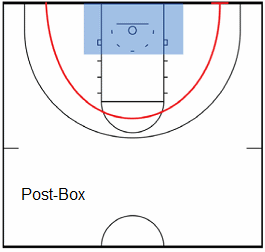
"Vegas Close-outs" Drill
Close-outs, being one of the most important fundamentals of this defense, must be worked on every day (including pre-game warm-ups)."Close out with two high hands" - Two high hands are used instead of one because it discourages rhythm shots and quick passes over the top, and creates a mentality of taking away the shooter's vision.
Drill: "Vegas Close-outs" - do this drill every day (practice, shoot around, pre-game warm-ups, etc.)
Each defender tosses the ball to offensive player and closes out with two high hands. Elbows are bent. Use a low stance and short/choppy steps. Stay square and yell "SHOT" early.
The offensive player will catch in triple-threat, jab step and rip the ball through a couple of times.
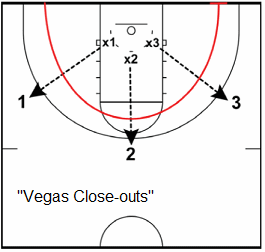
"2-on-1 Position" Drill
Coach starts with the ball, X1 is matched up with O1.Coach can pass to O1, dribble him out, cut him through, etc. forcing X1 to play on and off the ball.
Drill lasts for a prescribed amount of time, and no one looks to score as we are just focusing on constant offensive movement.
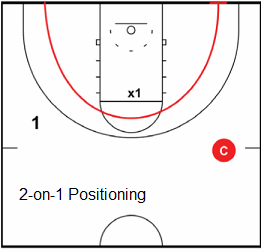
Coaching Points: Make sure X1 plays with proper fundamentals throughout the drill:
- Close outs from ball to help & help to ball
- Jump & Swipe
- Bump Cutter
- Protect against baseline & straight line drives
- Intense ball pressure
"Blackhawk" Drill
This drill works on gap positioning, bumping the cutter, close-outs and 1-on-1 defense. See diagram 24. X1 closes out on O1. O1 passes to either wing and X1 jumps to the ball in the gap - Coach Mack uses the term "jump and swipe" with the outside arm out in the gap looking to swipe. Gap defenders must be active.O1 cuts through (diagram 25) and X1 bumps the cutter and goes with O1 to a point just below the free-throw line. The wing player always passes back to the top (diagram 26), where O4 steps in from the line to take the next pass (from O3). X1 closes out on O4 with high hands.
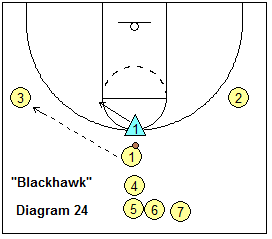
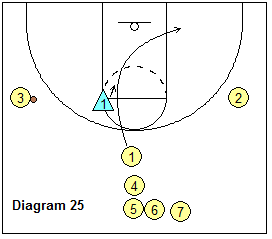
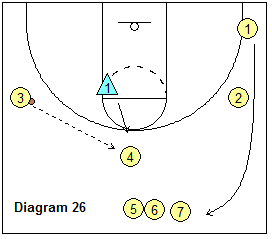
O4 passes again to either wing (diagram 27). X1 again jumps to the ball into the gap. O4 cuts through and X1 bumps the cutter. O2 passes back to the top O5. X1 closes-out. Repeat these steps until X1 gets three or four close-out reps, and then yell "Live!". At this point (diagram 28) the offensive player on the point attacks 1-on-1, permitted only two or three dribbles, as X1 defends the dribble. Then start over with a new defender.
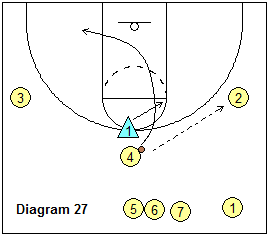
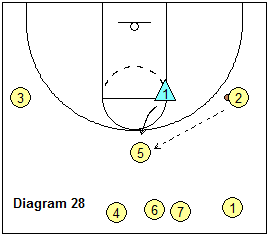
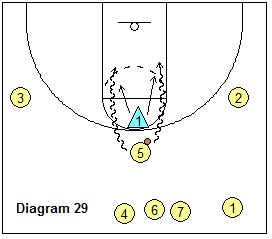
Post Positioning and Drills
Golden Rule: NEVER GIVE UP POST FEEDS FROM THE TOP
1. Post defender should always be "on the line, up the line" when ball is up top.
2. A post defender's work should be done before the ball is ever passed.
3. On a post catch:
4. Undisciplined post defenders try to block their own man's shots
2. A post defender's work should be done before the ball is ever passed.
a. Use an armbar to push the post player out of the "post box" before the catch.
b. Play 3/4 on the high side (except if player flashes to the high post).
b. Play 3/4 on the high side (except if player flashes to the high post).
3. On a post catch:
a. "Pop Back" - Move from 3/4 high-side position to behind, keep a boxer's stance.
b. "Wall Up" - As post makes move, show the ref your hands and hold position with your lower body and try to walk through the offensive player.
c. "Walk through the shooter!".
d. "Walling up" also provides great box out positioning and prevents easy offensive rebounds.
e. "Show the ref your hands and foul the hell out of him with your hips".
b. "Wall Up" - As post makes move, show the ref your hands and hold position with your lower body and try to walk through the offensive player.
c. "Walk through the shooter!".
d. "Walling up" also provides great box out positioning and prevents easy offensive rebounds.
e. "Show the ref your hands and foul the hell out of him with your hips".
4. Undisciplined post defenders try to block their own man's shots
a. The on-ball post defender should never leave his feet when walling up, even when the shot goes up.
b. For every one block a player may get, he'll pick up three fouls.
c. Great shot blockers get their swats from a help position.
b. For every one block a player may get, he'll pick up three fouls.
c. Great shot blockers get their swats from a help position.
3-out, 1-in Guarded Drill
The drill begins with the ball on the wing.The offensive post tries to get position inside the box, as the post defender plays 3/4 on the high side and uses arm bar to force a catch outside the box.
On a pass from wing to top, the post defender plays "on the line, up the line" as the offensive post tries to leg whip and seal. The post defender can't play too high and give up lob.
On a pass from the top to opposite wing, the post defender hits the offensive post with an arm bar and "peels" to resume 3/4 high side positioning outside the post box.
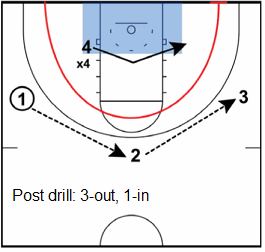
1-on-1 Wall Up Drill
This drill works on "walling up" against shot attempts from offensive rebounds.A coach will lob the ball up off of backboard to offensive player O1.
O1 will rebound the ball, and X1 will "wall up" and try to push O1 out of the post box with his hips.
- "Show the ref your hands".
- Do not leave your feet!
O1 does not try to shoot, but rather just battles for shooting position inside the post box.
After a few pivots, O1 will pass the ball back to Coach who will then repeat the drill on the opposite side with player O2.
Run this drill for a prescribed number of reps.
Optional conclusion to drill: X1 has to finish drill by taking a charge from either O1 or O2 lowering their shoulder.
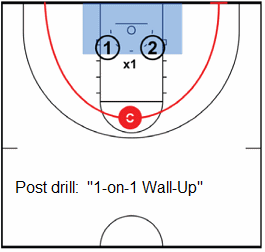
Coaching Point: So many offensive players will throw up bad lay-up attempts either because their feet aren't set, or because their positioning is poor in relation to the basket.
Defending the Post from the Perimeter Drill
"Crowding the Post" - pressure the post by sagging in from the outside.- This requires great COMMUNICATION!
- All defenders must have an open stance.
- Perimeter players must be in "two places at once".
"See both" the post player and your man - and be able to close out correctly on the pass out.
X2 has his/her "butt to baseline".
X3 will help on X1's man.
- The most likely pass out of the post is to the top.
- X3 will "jump and swipe" on X1's man to hold him up until X1 closes out.
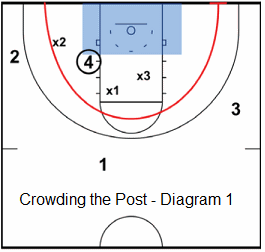
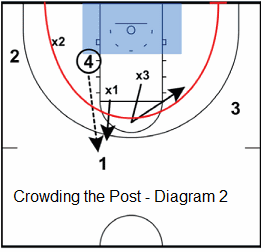
3-on-3 Identity Drill
Xavier runs this drill almost daily.Coach is under basket and passes ball to one of the three offensive players.
Offense has 20 seconds to score.
- Offense can do whatever they want to score but ball screen.
- 3 dribble max per touch.
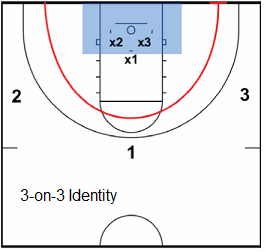
Early season practice: 4-5 possessions for each team.
In-season practice: 2-3 possessions for each team.
Scoring:
- 3 pt shot = +3
- 2 pt shot = +2
- TO = -1 for offense
- Foul = -1 for defense (still same possession)
- Off. Rebound = +2
- If ball ever goes inside of post box (not including offensive rebound) = +2 (still same possession)
3-Out, 1-In Identity Drill
Use the same rules as above, just add a post player and a post defender.See the complete article in the members section.
Sign up now!
The complete article also includes:
- 4-on-4 Drills
- 5-on-5 Drills
Related pages: